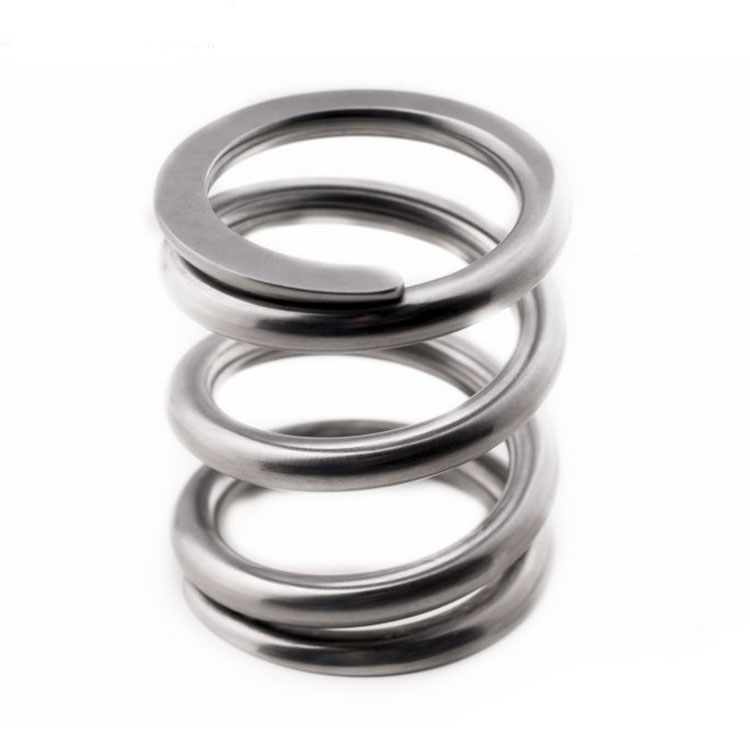News center
What are the typical processes of springs?
- 分类:Share
- 发布时间:2022-10-17 09:01:09
【概要描述】The process of forming a phosphating film on metal parts in an acidic solution containing an alkali metal phosphorus salt of an accelerator is called iron-based phosphating or amorphous phosphating.
What are the typical processes of springs?
【概要描述】The process of forming a phosphating film on metal parts in an acidic solution containing an alkali metal phosphorus salt of an accelerator is called iron-based phosphating or amorphous phosphating.
- 分类:Share
- 发布时间:2022-10-17 09:01:09
- 访问量:
The process of forming a phosphating film on metal parts in an acidic solution containing an alkali metal phosphorus salt of an accelerator is called iron-based phosphating or amorphous phosphating. Compared with the heavy metal phosphate phosphating solution (PH: 1.5~3), its pH: 6 or less can be operated. The film-forming mechanism of the two solutions is different. The amorphous phosphating film is composed of iron oxide (Fe203) and iron phosphate ( FeP04 2H20) Composition。
1. Characteristics of phosphating film
The amorphous phosphating film formed on steel is hydrophobic. This property can reduce the blistering of the paint film, but it is poor in preventing corrosion from expanding under the paint film. Therefore, the protective performance is lower than that of zinc-based phosphating. But no matter what, it's far better than painting over bare metal.
The iron-based phosphating film has a wide range of colors, such as gray, blue-green, purple, blue, etc. The film is very thin, and the film weight is generally 0.2~1.0g/m2, so this film is especially suitable for the bottom layer of paint, especially for paint. The membrane is subjected to large mechanical deformations, such as leaf springs, coil springs, torsion springs, etc. Working in a less severe corrosive environment can meet the protection requirements. Sometimes this treatment is also used for inter-process protection.
2. Typical process flow
The surface of the material to be treated must be rust-free. Pickling is not allowed in principle. The best process is a five-step process:
a) Alkaline degreasing: b) water washing; c) phosphating; d) water washing; e) passivation water washing.
The most commonly used construction method is the liquid spray method, because most of the immersion method will form powdery precipitates on the membrane.
3. Phosphating solution control
In the production process, the pH value (using test paper or pH meter), total acidity, free acidity, and alkalinity are mainly controlled. The determination of total acidity and free acidity is the same as that of crystal phosphating. Determination of Alkalinity Take 10ml of phosphating solution, use bromocresol green as indicator, and titrate with 0.1N hydrochloric acid or sulfuric acid solution to light green as the end point. The number of milliliters consumed by titration is the point of alkalinity.

4. Anti-rust phosphating
The phosphating used for protection belongs to thick film phosphating, the film thickness is more than 20um, and the film weight is generally 10~30g/m2, or even heavier. In order to achieve a good protection performance, the parts should be impregnated with oil, grease or wax after phosphating treatment to further improve the anti-corrosion performance. Commonly used in solid parts, springs, etc.
In principle, this type of film cannot be used as the bottom layer of an organic coating film. It is very sensitive to mechanical deformation. When subjected to deformation, the film will crack and loosen, causing the parts to separate from the paint film. In addition, the paint consumption is high, and the gloss and finish are poor.
(1) Slow Phosphating
The bath solution is composed of one or two of zinc dihydrogen phosphate, manganese dihydrogen phosphate, ferric dihydrogen phosphate and free phosphoric acid. Since there is no oxidant, the concentration of Fe2+ ions increases with the increase of the treatment area, and the sediment increases accordingly. The processing time takes 40~60 minutes.
(2) Accelerated high temperature phosphating
Adding N03-, CI03-, etc. to the above-mentioned phosphating solution can greatly shorten the phosphating time. Their function lies in the hydrogen ions generated by the reaction of iron oxide with acid and the ferrous ions generated by the dissolution of iron, which can maintain the content of Fe2+ in the solution. The content is always on one level.
In the phosphating solution containing accelerator, although the content of zinc is reduced at the beginning, under a certain acid ratio, the whole process of using the bath solution can be kept at a constant level, and the composition of the phosphating film will not be affected by the treatment area. significantly changed. In addition, the deposits in the phosphating tank containing the accelerator are significantly less than those without the accelerator. The anti-corrosion performance of the phosphating film remains unchanged, and the service life of the bath is obviously extended.
During the production process, the solution should be regularly tested and replenished to maintain a uniform film quality. There are many ways to put parts into the slot. For larger work, special spreader or basket is used; for large quantities of small parts, rollers can be used.
For the purpose of energy saving, the reduction of phosphating temperature without affecting the formation of a thick enough film is undoubtedly the direction people are pursuing. The latest research results show that adjusting the components can reduce the original temperature from 92-98°C to 65-85°C, and the phosphating film can be dripped with standard copper sulfate solution for 20-30 minutes without rust.
High-carbon steel and high-carbon low-alloy can form black or dark gray-black film, and medium and low carbon steel can only form silver-gray to gray film. If black phosphating film is required, three methods can be used: one is dyeing before phosphating, The second is black phosphating (the black dye is added to the phosphating solution), and the third is blackening after phosphating.
